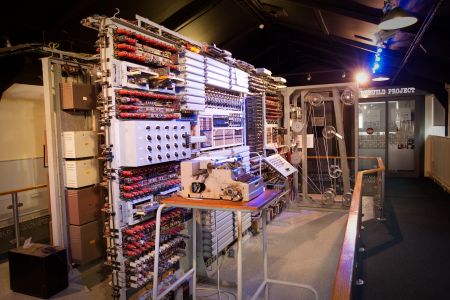The National Museum of Computing has celebrated the 70th birthday of the Colossus computer, which helped decypher German messages during the second world war, with an event featuring a demonstration of a reconstructed Colossus cracking a code.
“The achievements of those who worked at Bletchley Park are humbling,” said museum chair Tim Reynolds in a statement. “This day is in honour of all the men and women who worked on breaking the Lorenz cipher.”
Decryption
Colossus Mark I, used to read messages sent between Hitler and his generals that had been encrypted using the Lorenz code, was given its first task on 5 February, 1944. By the end of the war 10 of the machines were in operation in the UK and had been used to decrypt 63 million characters of German messages.
 The computer was built by an engineer called Tommy Flowers, the son of a bricklayer who worked for the General Post Office’s telecoms division (later to become BT) at the Royal Arsenal, Woolwich. The machine, now accepted to have been the first electronic computer, measured 7ft high by 17ft wide and 11ft deep, and weighed five tonnes.
The computer was built by an engineer called Tommy Flowers, the son of a bricklayer who worked for the General Post Office’s telecoms division (later to become BT) at the Royal Arsenal, Woolwich. The machine, now accepted to have been the first electronic computer, measured 7ft high by 17ft wide and 11ft deep, and weighed five tonnes.
It used 8kW of power and incorporated parts from telephone exchanges including 2,500 valves, about 100 logic gates and 10,000 resistors, connected by 7km of wiring.
It could read an estimated 5,000 characters per second, meaning it could take only about four hours to find the first key in a code. As a result Colossus is thought to have substantially shortened the duration of the war.
However, its contributions were unknown until the 1970s, as the Colossus programme’s existence was kept secret for 30 years after the end of the war, while all but two of the machines were broken up and the plans used to build them destroyed. This effort to keep the work secret was in part due to the fact that Britain was still using two of the machines to help crack Soviet codes.
The working Colossus replica on display at the National Museum of Computing was reconstructed by Tony Sale, the museum’s co-founder, based on eight photographs of the machine taken in 1945 and a few surviving circuit diagrams.
Wednesday’s event was attended by some of the women who kept the Colossus machines running and the engineers who built and maintained them, as well as some of the children of the machine’s creators and operators. During the war about 550 people worked in the unit at Bletchley Park that operated Colossus.
The museum’s triumph in restoring Colossus is somewhat overshadowed by a disagreement with the overall Bletchley Park Trust, which manages the site, including other exhibits sponsored by tech firms including McAfee. The Museum has accused the Trust of isolating it by excluding it from guided tours. The Trust, meanwhile, has said the new tour format is necessary to shorten tour times and has said its actions are in the interest of creating a “high-quality heritage attraction”.
Are you a security pro? Try our quiz!




